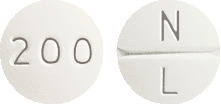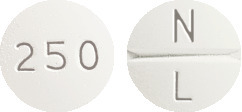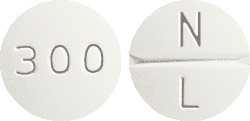SUMMARY CMI
NUELIN-SR® Tablets
Consumer Medicine Information (CMI) summary
The full CMI on the next page has more details. If you are worried about using this medicine, speak to your doctor or pharmacist.
1. Why am I taking Nuelin-SR?
Nuelin-SR tablets contain the active ingredient theophylline which causes the muscle lining of the airways to relax. Nuelin-SR is a slow-release medicine, which means each tablet works for about 12 hours. Nuelin-SR tablets are used to treat asthma and other conditions where breathing is difficult. It also helps to prevent asthma attacks.
For more information, see Section 1. Why am I taking Nuelin-SR? in the full CMI.
2. What should I know before I take Nuelin-SR?
Do not use if you have ever had an allergic reaction to Nuelin-SR tablets, theophylline, aminophylline, caffeine or any of the ingredients listed at the end of the CMI.
Talk to your doctor if you have any other medical conditions, take any other medicines, or are pregnant or plan to become pregnant or are breastfeeding.
For more information, see Section 2. What should I know before I take Nuelin-SR? in the full CMI.
3. What if I am taking other medicines?
Some medicines may interfere with Nuelin-SR tablets and affect how it works.
A list of these medicines is in Section 3. What if I am taking other medicines? in the full CMI.
4. How do I take Nuelin-SR?
- Adults: the usual dose is one tablet every 12 hours. Your doctor may vary the dose, so follow their instructions exactly.
- Children over 2 years: the dose depends on the child's body weight, so follow your doctor's instructions exactly.
- Take Nuelin-SR every 12 hours with or immediately after food and continue taking it until your doctor tells you to stop.
More instructions can be found in Section 4. How do I take Nuelin-SR? in the full CMI.
5. What should I know while taking Nuelin-SR?
| Things you should do |
|
| Things you should not do |
|
| Driving or using machines |
|
| Drinking alcohol |
|
| Looking after your medicine |
|
For more information, see Section 5. What should I know while taking Nuelin-SR? in the full CMI.
6. Are there any side effects?
Common side effects include nausea and vomiting, stomach pains, headaches, a loss of appetite, feeling restless, nervous or irritable and difficulty sleeping. Serious side effects include heart rhythm disturbances and fits.
For more information, including what to do if you have any side effects, see Section 6. Are there any side effects? in the full CMI.
FULL CMI
NUELIN-SR® Tablets (new-lin s r tab-lets)
Active ingredient: Theophylline (thee-off-o-lin)
Consumer Medicine Information (CMI)
This leaflet provides important information when taking Nuelin-SR Tablets. You should also speak to your doctor or pharmacist if you would like further information or if you have any concerns or questions about using Nuelin-SR Tablets.
Where to find information in this leaflet:
1. Why am I taking Nuelin-SR?
2. What should I know before I take Nuelin-SR?
3. What if I am taking other medicines?
4. How do I take Nuelin-SR?
5. What should I know while taking Nuelin-SR?
6. Are there any side effects?
7. Product details
1. Why am I taking Nuelin-SR?
Nuelin-SR Tablets contain the active ingredient theophylline, which causes the muscle lining of the airways to relax. Nuelin-SR is a slow-release medicine, which means each tablet works for about 12 hours.
Nuelin-SR is used to treat asthma and other conditions where breathing is difficult. It also helps to prevent asthma attacks.
2. What should I know before I take Nuelin-SR?
Warnings
Do not take Nuelin-SR:
- If you are allergic to any medicines containing theophylline, aminophylline or caffeine; or to any of the ingredients listed at the end of this leaflet. Some of the symptoms of an allergic reaction may include:
- shortness of breath
- wheezing or difficulty breathing
- swelling of the face, lips, tongue or other parts of the body
- rash, itching or hives on the skin - Always check the ingredients to make sure you can use this medicine
- Do not use Nuelin-SR if the packaging is torn or shows signs of tampering.
Check with your doctor if you:
- Have allergies to any medicines, foods, preservatives or dyes
- Have a stomach ulcer or reflux
- Have an irregular or rapid heartbeat or any other heart disease
- Have very high blood pressure
- Have a viral infection or a fever
- Have liver, thyroid or lung disease
- Take any medicines for any other condition.
During treatment, you may be at risk of developing certain side effects. It is important you understand these risks and how to monitor for them. See additional information under Section 6. Are there any side effects?
Pregnancy and breastfeeding
Before taking Nuelin-SR check with your doctor if you are pregnant or intend to become pregnant. Nuelin-SR may affect your developing baby if you take it during pregnancy.
Talk to your doctor if you are breastfeeding or intend to breastfeed. The active ingredient in Nuelin-SR passes into breast milk. Irritability has been reported in infants of nursing mothers taking theophylline.
Use in Children
Do not give Nuelin-SR tablets to children under 2 years of age.
Nuelin-SR Syrup is available as an alternative to tablets for use in children 2 years and over.
3. What if I am taking other medicines?
Tell your doctor or pharmacist if you are taking any other medicines, including any medicines, vitamins or supplements that you buy without a prescription from your pharmacy, supermarket or health food shop.
Some medicines may interfere with Nuelin-SR and affect how it works.
Drugs that may increase the effect of Nuelin-SR include:
- Cimetidine – used to treat heartburn indigestion, stomach ulcers or reflux
- Allopurinol – used to treat gout
- Propranolol – used to reduce anxiety, relieve tremors and prevent migraine, angina, and high blood pressure
- Antibiotics, such as erythromycin, clarithromycin, ciprofloxacin or enoxacin
- Alcohol
- Oral contraceptives
- Mexilitene or verapamil – used to treat high blood pressure, angina or other heart conditions
- Tacrine – used to treat Alzheimer's disease
- Thiabendazole – used to treat infections caused by worms
- Disulfiram – used to treat alcoholism
- Interferon alpha – used to treat different types of cancer
Drugs that may reduce the effect of Nuelin-SR include:
- Tobacco or marijuana
- Phenobarbitone, phenytoin or carbamazepine – used to treat epilepsy
- Lithium
- Rifampicin – used to treat tuberculosis or leprosy
- Hypericum perforatum (St John's wort)
Tell your doctor if you are taking medication containing any of the following:
- Halothane
- Ketamine
- Ranitidine
- Diltiazem
- Nifedipine
- Isoniazid
- Frusemide
- Influenza vaccine (flu vaccine)
- Corticosteroids
- Cold and flu medicines.
Taking these medicines and Nuelin-SR at the same time may affect how each medication works.
Your doctor may wish to monitor your theophylline blood levels you while you are taking Nuelin-SR.
Check with your doctor or pharmacist if you are not sure about what medicines, vitamins or supplements you are taking and if these affect Nuelin-SR.
4. How do I take Nuelin-SR?
How much Nuelin-SR to take
- Follow the dosage instructions on your Nuelin-SR tablets bottle label. The dosage may differ from the advice provided in this leaflet
- Adults: the usual dose of Nuelin-SR is one tablet every 12 hours. However, this dose may be increased or decreased by your doctor
- Children over 2 years: the dose depends on the body weight of the child. Follow all instructions from your doctor when giving Nuelin-SR tablets to children
- Follow your doctor's instructions exactly. Never change the dose yourself. Continue taking Nuelin-SR until your doctor tells you to stop taking it.
When to take Nuelin-SR
- Take Nuelin-SR as your doctor has told you to, even if you are not suffering any asthma symptoms
- Take Nuelin-SR tablets every 12 hours, with or immediately after food so that it does not upset your stomach
- Nuelin-SR works best when there is a certain amount of theophylline in your blood. Your doctor may sometimes need to take samples of your blood to check the level of theophylline.
How to take Nuelin-SR
- Take Nuelin-SR with a full glass of water. DO NOT chew or crush the tablets.
If you forget to take Nuelin-SR
Take the tablets regularly at the same time each day. If you miss your dose at the usual time, take it as soon as you remember.
However, if it is more than 4 hours late, skip the dose that you missed and take your next dose when you are meant to. Do not take a double dose to make up for the dose you missed.
If you take too much Nuelin-SR
If you take too many tablets you may feel irritable, agitated, or anxious; feel sick and vomit or are unable to sleep. More severe effects include a rapid or irregular heartbeat, feeling very thirsty or experiencing fever, confusion or fits.
If you think that you have taken too much Nuelin-SR, you may need urgent medical attention.
You should immediately:
- phone the Poisons Information Centre
(by calling 13 11 26), or - contact your doctor, or
- go to the Emergency Department at your nearest hospital.
You should do this even if there are no signs of discomfort or poisoning.
5. What should I know while taking Nuelin-SR?
Things you should do
If you have an asthma attack, use your relieving inhaler to help with your asthma.
Nuelin-SR will not give you relief during an asthma attack as it does not work quickly enough.
If you are about to start on any new medicines, remind your doctor, dentist and pharmacist that you are taking Nuelin-SR tablets.
If you are going to have surgery, tell the surgeon or anaesthetist that you are taking Nuelin-SR. It may affect other medicines used during surgery.
If you are about to have any blood tests tell your doctor that you are taking Nuelin-SR. It may interfere with the results of some tests.
Keep all doctor's appointments so that your progress can be checked.
Call your doctor straight away if you:
- Think your asthma is getting worse or if you suffer asthma attacks
- Become pregnant while taking Nuelin-SR.
Remind any doctor, dentist or pharmacist you visit that you are taking Nuelin-SR.
Things you should not do:
- Do not take Nuelin-SR tablets to treat any other complaints unless your doctor tells you to
- Do not give your medicine to anyone else, even if they have the same condition as you
- Do not stop taking your medicine or lower the dosage without checking with your doctor.
Driving or using machines
Be careful before you drive or use any machines or tools until you know how Nuelin-SR affects you.
Drinking alcohol
Tell your doctor if you drink alcohol.
Alcohol may increase the effects of Nuelin-SR tablets.
Looking after your medicine
- Store below 30°C.
- Store Nuelin-SR tablets in the bottle until it is time to take them.
Store it in a cool dry place away from moisture, heat or sunlight; for example, do not store it:
- in the bathroom or near a sink, or
- in the car or on window sills.
Keep it where young children cannot reach it.
Getting rid of any unwanted medicine
If you no longer need to use this medicine or it is out of date, take it to any pharmacy for safe disposal.
Do not use this medicine after the expiry date.
6. Are there any side effects?
All medicines can have side effects. If you do experience any side effects, most of them are minor and temporary. However, some side effects may need medical attention.
See the information below and, if you need to, ask your doctor or pharmacist if you have any further questions about side effects.
Less serious side effects
| Less serious side effects | What to do |
Common side effects
| Speak to your doctor if you have any of these less serious side effects and they worry you. |
Serious side effects
| Serious side effects | What to do |
| Call your doctor straight away, or go straight to the Emergency Department at your nearest hospital if you notice any of these serious side effects. |
Tell your doctor or pharmacist if you notice anything else that may be making you feel unwell.
Other side effects not listed here may occur in some people.
Reporting side effects
After you have received medical advice for any side effects you experience, you can report side effects to the Therapeutic Goods Administration online at www.tga.gov.au/reporting-problems. By reporting side effects, you can help provide more information on the safety of this medicine.
Always make sure you speak to your doctor or pharmacist before you decide to stop taking any of your medicines.
7. Product details
This medicine is only available with a doctor's prescription.
What Nuelin-SR Tablets contain
| Active ingredient (main ingredient) | Theophylline |
| Other ingredients (inactive ingredients) | Guar gum Magnesium stearate |
| Potential allergens | None |
Do not take this medicine if you are allergic to any of these ingredients.
What Nuelin-SR looks like:
Nuelin-SR 200 mg tablets are small white tablets marked N/L on one side and 200 on the other and come in a bottle of 100 tablets (Registration number: AUST R 59526).
Nuelin-SR 250 mg tablets are small white tablets marked N/L on one side and 250 on the other and come in a bottle of 100 tablets (Registration number: AUST R 46069).
Nuelin-SR 300 mg tablets are small white tablets marked N/L on one side and 300 on the other and come in a bottle of 100 tablets (Registration number: AUST R 59527).
Who distributes Nuelin-SR:
iNova Pharmaceuticals (Australia) Pty Limited
Level 10, 12 Help Street
Chatswood NSW 2067
Tel: 1800 630 056
This leaflet was prepared in November 2022.
Published by MIMS January 2023




 Nuelin Syrup is best taken an hour before meals with a glass of water, or if necessary with or immediately after meals to lessen gastro-intestinal irritation.
Nuelin Syrup is best taken an hour before meals with a glass of water, or if necessary with or immediately after meals to lessen gastro-intestinal irritation.
